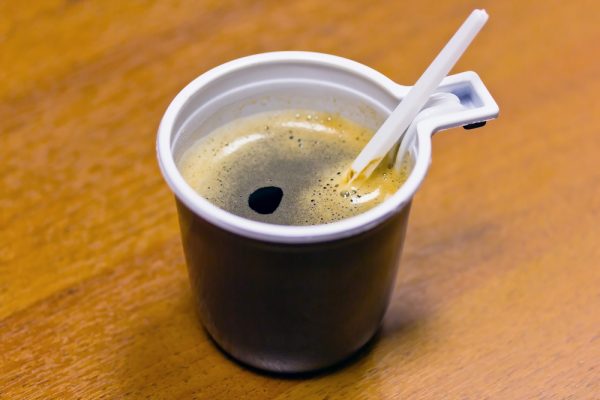Are you someone who enjoys drinking coffee on-the-go? Do you often find yourself grabbing a plastic cup to hold your hot coffee? If so, you may be wondering if it’s safe to put hot coffee in a plastic cup. The answer is not as straightforward as you may think.
While technically, you can put hot coffee in a plastic cup, it’s not recommended. When you pour hot liquid into a plastic cup, a phenomenon called migration can occur. This is when the chemicals from the plastic can leach into your drink and potentially harm your health. Different types of plastic cups can have different levels of risk, so it’s important to know what kind of plastic your cup is made of before using it for hot liquids.
The Basics of Plastic and Heat
Understanding Plastic
Plastic is a synthetic material made from polymers, which are long chains of molecules. These molecules can be manipulated to create different types of plastic with varying properties. Some plastics are more heat-resistant than others, and some are more prone to melting or warping when exposed to high temperatures.
Effects of Heat on Plastic
When plastic is exposed to heat, it can start to break down and release chemicals into the surrounding environment. This is known as “off-gassing.” The effects of heat on plastic can vary depending on the type of plastic and the temperature it is exposed to.
For example, PVC (polyvinyl chloride) begins to melt at boiling temperature, while polystyrene starts to melt at a slightly higher temperature. However, even at temperatures around 100 degrees Fahrenheit, migration can occur, which means that chemicals from the plastic can leach out into your drink.
When it comes to drinking hot coffee, it’s important to consider the type of plastic cup you’re using. Not all plastic cups are created equal, and some are more heat-resistant than others. It’s also important to note that the temperature of your coffee can play a role in how much plastic chemicals leach into your drink.
In summary, the effects of heat on plastic can be complex and vary depending on several factors. When it comes to drinking hot coffee in a plastic cup, it’s important to consider the type of plastic and the temperature of your coffee to minimize your exposure to potentially harmful chemicals.
The Science Behind Hot Coffee
When you order a hot coffee to-go, you might not give much thought to the cup it’s served in. However, the type of cup you use can have an impact on the taste and safety of your coffee. In this section, we’ll take a closer look at the science behind hot coffee and plastic cups.
Temperature of Hot Coffee
First, let’s talk about the temperature of hot coffee. When you order a hot coffee, it’s typically served between 160-185°F (71-85°C) depending on the coffee shop. This high temperature is what makes coffee so enjoyable to drink, as it releases the flavors and aromas of the beans.
However, this high temperature can also have an impact on the cup it’s served in. Plastic cups are not designed to withstand high temperatures, and can begin to melt or warp when exposed to hot liquids for an extended period of time. This can not only affect the taste of your coffee, but can also pose health risks.
Effects of Hot Coffee on Plastic
When you pour hot coffee into a plastic cup, the heat can cause chemicals from the plastic to leach into your drink. This is especially true if the plastic cup is not labeled as “heat-resistant” or “microwave-safe.” These chemicals can be harmful to your health, and can cause a range of issues from nausea to cancer.
In addition to the health risks, the plastic cup can also affect the taste of your coffee. The chemicals from the plastic can alter the flavor of your coffee, making it taste bitter or metallic.
To ensure the safety and quality of your hot coffee, it’s best to avoid using plastic cups altogether. Instead, opt for ceramic, glass, or stainless steel cups which are designed to withstand high temperatures and are less likely to leach harmful chemicals into your drink.
In summary, the temperature of hot coffee can have an impact on the cup it’s served in, and plastic cups are not designed to withstand high temperatures. When you pour hot coffee into a plastic cup, it can cause harmful chemicals to leach into your drink and alter the taste. To ensure the safety and quality of your hot coffee, it’s best to use a cup that is designed to withstand high temperatures and is labeled as “heat-resistant” or “microwave-safe.”
Potential Risks
Health Concerns
Plastic cups are a popular choice for serving hot drinks like coffee, but there are some potential health concerns associated with using them. When hot liquids are poured into plastic cups, the heat can cause the plastic to release harmful chemicals into the drink. These chemicals, such as bisphenol A (BPA) and phthalates, have been linked to a variety of health problems, including cancer, reproductive issues, and developmental problems in children.
While some plastic cups are labeled as “BPA-free,” this doesn’t necessarily mean they are completely safe. Other chemicals in plastic can also be harmful, and there is still some debate among experts about how much exposure to these chemicals is safe. To minimize your risk, it’s best to avoid using plastic cups for hot drinks whenever possible.
Environmental Impact
In addition to the potential health risks, using plastic cups for hot drinks can also have a negative impact on the environment. Plastic cups are not biodegradable, which means they can take hundreds of years to break down in landfills. They also contribute to the growing problem of plastic pollution in the oceans, where they can harm marine life and disrupt ecosystems.
To reduce your environmental impact, consider using reusable cups made from materials like glass or stainless steel. These cups can be washed and used again and again, reducing the amount of waste you produce. If you do need to use a disposable cup, look for options that are made from biodegradable or compostable materials, such as paper or plant-based plastics.
Overall, while it may be convenient to use plastic cups for hot drinks like coffee, there are some potential risks to consider. By choosing alternative materials and being mindful of your environmental impact, you can help protect your health and the planet.
Alternatives to Plastic Cups
If you’re concerned about the safety of plastic cups and want to avoid the potential risks, there are several alternatives you can consider. Here are a few options you can explore:
Reusable Cups
One of the best alternatives to plastic cups is to use reusable cups made of materials like glass, ceramic, or stainless steel. These cups are durable, easy to clean, and can be used multiple times, making them an eco-friendly choice. Plus, they come in a variety of sizes and designs, so you can find one that suits your needs and style.
Reusable cups are also a great way to keep your coffee hot for longer periods of time. Unlike plastic cups, which can absorb heat and cause the coffee to cool down quickly, reusable cups made of materials like stainless steel can keep your coffee hot for up to 12 hours.
Biodegradable Cups
If you’re looking for a more eco-friendly option than plastic cups, you can try biodegradable cups made from materials like paper, bamboo, or cornstarch. These cups are designed to break down quickly and easily, reducing the amount of waste that ends up in landfills.
Biodegradable cups are also a great choice for outdoor events or parties, as they are lightweight and easy to transport. Plus, they come in a variety of sizes and designs, so you can find one that suits your needs and style.
However, it’s important to note that not all biodegradable cups are created equal. Some may contain harmful chemicals or additives that can be harmful to the environment. So, be sure to do your research and choose a reputable brand that uses safe and sustainable materials.
In summary, there are several alternatives to plastic cups that you can consider, including reusable cups made of materials like glass or stainless steel, and biodegradable cups made from materials like paper or bamboo. By choosing one of these options, you can reduce your environmental impact and enjoy your coffee with peace of mind.
Conclusion
In summary, while plastic cups may be convenient for holding hot coffee, it is not recommended to use them for this purpose. The risk of the plastic melting or warping and leaching harmful chemicals into the coffee is too great.
If you must use a plastic cup for hot coffee, choose a cup specifically designed for hot beverages and made from a type of plastic that is safe for hot liquids, such as polypropylene. However, it is still recommended to use a ceramic or glass mug for hot coffee to avoid any potential health risks.
Remember to always prioritize your health and safety when choosing the materials you use to consume your beverages. While plastic cups may be easy and convenient, they may not always be the best option for your health.
Frequently Asked Questions
Is it safe to put hot beverages in plastic cups?
While plastic cups are convenient, they are not necessarily safe for hot beverages. Some plastic cups can release harmful chemicals when exposed to high temperatures, which can be dangerous to your health.
What are the risks of drinking hot beverages in plastic cups?
The risks of drinking hot beverages in plastic cups include the release of harmful chemicals, such as bisphenol A (BPA) and phthalates, which can leach into your drink and potentially cause health problems.
Can plastic cups handle hot coffee without melting?
It depends on the type of plastic cup. Some plastic cups are designed to handle hot beverages, while others are not. If you are unsure whether a plastic cup can handle hot coffee, it is best to err on the side of caution and use a different container.
What types of plastic cups are safe for hot drinks?
Plastic cups made from polypropylene (PP) are generally considered safe for hot drinks. PP is a durable plastic that can withstand high temperatures without releasing harmful chemicals. However, it is still important to check the label of the plastic cup to ensure it is safe for hot beverages.
Are paper cups a safer option for hot drinks?
Paper cups are generally considered a safer option for hot drinks, as they are less likely to release harmful chemicals when exposed to high temperatures. However, paper cups are not as durable as plastic cups and are not suitable for prolonged use.
Can hot jello be poured into plastic cups without melting them?
It is not recommended to pour hot jello into plastic cups, as the heat can cause the cups to melt and release harmful chemicals. It is best to let the jello cool down before pouring it into a plastic cup, or use a different container altogether.

